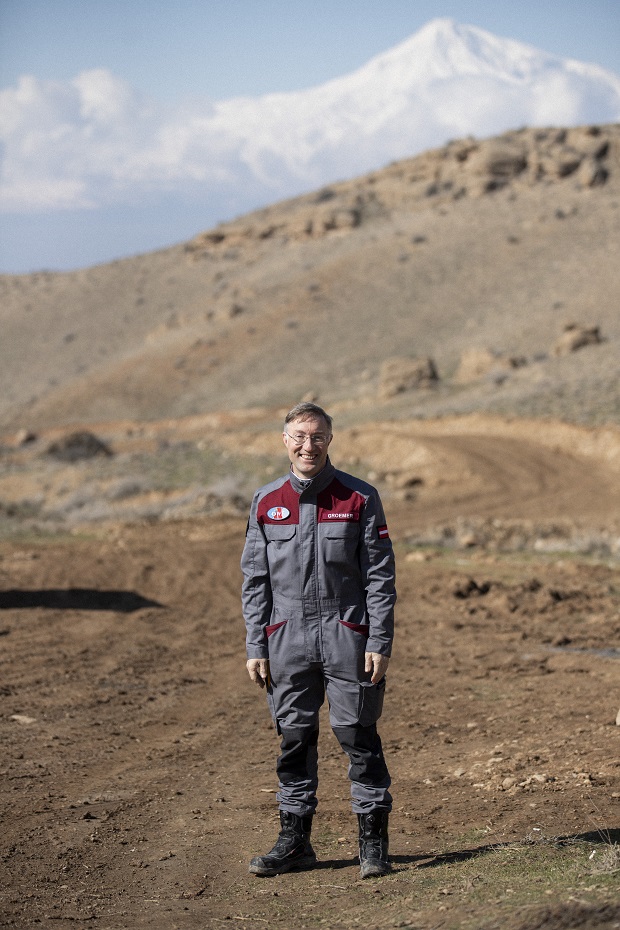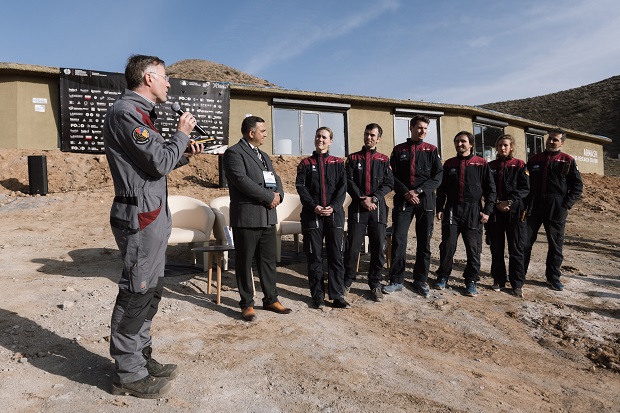
Whatever the path to Mars looks like, there will be some Armenian DNA: Gernot Grömer
3 years of preparations, 6 analog astronauts, 13 experiments conducted, and 250 researchers involved. For a month, Armenia appeared in the center of attention of the Mars research world, as it hosted the 14th International Mars Analog Research Mission, “AMADEE-24.” The latter was organized and implemented this year by the "Armenian Aerospace Agency" and the "Armenian Space Forum," with management overseen by the "Austrian Space Forum (OeWF)." Gernot Grömer, the director of the “Austrian Space Forum shares insights into the collective journey that led them to Armenia, the significance of this mission, and the lasting impact it holds for both Armenia and the future of Mars exploration.
A step to Armenia or a step closer to Mars
"Fail fast, fail cheap, and have a steep learning curve" – this is our guiding philosophy. Our journey into analog research began in 2003. Over 20 years ago, we recognized the need for operational research to pave the way for future human-robotic planetary surface missions. We believed it was time to venture into the field with our assets, get our hands dirty, break things, and learn rapidly. Thus, our primary goal became not to fear challenges and mistakes but to embrace them and continually learn.
Design, build, use, overuse, redesign, repeat: It was this continuous and magical cycle that propelled us towards the 14th International Mars Analog Research Mission, “AMADEE-24,” this time set in Armenia.
I understand that Armenians are scattered across the globe (smiles), and we became aware of Armenia's potential through an Armenian researcher from the European Space Agency. So, we embarked on scouting expeditions, traversing various terrains, consulting with Armenian geologists, and evaluating over a dozen potential sites based on criteria like logistics, accessibility, and terrain details. You know that feeling when you take a child to a toy store, right? They're wide-eyed with excitement, pointing at one thing and then another, declaring, “This is what I want!” and then changing their mind a minute later with, "No, wait, this one! I experienced something similar in Armenia. Typically, when our seasoned scouting team explores potential test sites, we can already envision where a station might stand one day. After evaluating around ten locations, we ultimately settled on Armash because it was exactly what we were looking for. It was like catching a glimpse into the future. And this was the most exciting moment because when you have that gut feeling about a place, everything else just clicks into place.
Why exactly Armenia for “AMADEE-24?”
The project began nearly three years ago when we scouted potential host countries worldwide for “AMADEE-24.” The decision to choose Armenia was influenced by two factors. Firstly, from a geological perspective, the southern regions of Armenia resemble Martian terrain, with areas exhibiting Mars-like winds and landscapes. Secondly, we prefer to collaborate with countries that highly value innovation and progress. Armenia's rich heritage in space science and its cultural inclination towards innovation facilitated our deployment without extensive explanatory efforts. Over 26 nations and more than 250 researchers from various academic space research institutions and space agencies participated in the program.
“AMADEE-24” as a joint journey
Continuing our tradition and taking the first steps, we are proud to have hosted “AMADEE-24” in Armenia. This journey was a collaboration with the “Armenian Space Forum” and the “Armenian Aerospace Agency.” Beyond what meets the eye—analogue astronauts, stations, test sites, and robotics—lay the real know-how, decision-making workflows, and the scientific foundation of the Mission Support Center, alongside the operational contributions from the Armenian side. The extensive paperwork for each space hardware transfer to Armenia from the OeWF was another invisible aspect. Additionally, the month-long isolation profoundly impacted the analogue astronauts.

This mission stood out due to its scale; it was the largest mission we've undertaken, both in terms of research complexity and habitat size. Importantly, we all worked on the same side of the rope. The close relationship between Armenia and Austria fostered numerous networks and friendships, transcending scientific and engineering dimensions to encompass diplomatic and cultural spheres.
Throughout our collaboration, knowledge transfer was paramount. By training Armenian participants, we aimed to empower them to continue this work long after our departure. Our goal was to provide them with insights into the underlying technology, akin to revealing what's beneath the hood of a sports car. So, we did our best to accelerate, to catalyze, and to boost this field in Armenia.
Whatever the path to Mars looks like, people will remember that one of the initial steps was taken right here, in Armenia. Our planning horizon extends beyond our departure, envisioning continued collaboration between Armenia and Austria.
Unveiling Armenia’s rich heritage
I'm truly impressed by the hospitality diplomacy of the Armenians. From the delectable cuisine (laughs), exquisite wines, to the thoughtful consideration of hosts ensuring their guests aren't overwhelmed or fatigued, the experience is truly remarkable.
Furthermore, I'm deeply impressed by the rich cultural heritage that has persevered for thousands of years, despite facing numerous adversities and geopolitical challenges. The ability to maintain such a unique and deeply rooted culture has fostered remarkable societal cohesion. It is exemplified with this very strong and very patriotic expat community.

As I mentioned earlier, Armenia's cultural heritage is complemented by its significant scientific legacy. I take great pride in the fact that we weren't the first to introduce space exploration to Armenia. It has long been ingrained in Armenian innovation culture, stretching back many decades. I'm sure many of you are aware that the first Mars-roving robot was conceived under the leadership of Armenian researchers and scientists. Looking ahead, we hold a firm belief that the first human mission to Mars will take place within the next 20-30 years. This means that the very first human to walk on Mars was already born, perhaps attending elementary school in Armash or Yerevan.
Towards future endeavors
While I've only glimpsed a fraction of Armenia's innovative landscape, analog research is flourishing, promising further participation in future missions and continued collaboration.
The beauty of this mission lies in its authenticity. It's not a play, high-tech role-play, or a cinematic spectacle; it's reality. Regardless of the path we take to reach Mars, there will be some Armenian DNA, and the path of that beautiful journey will also bear the red, blue and orange of the Armenian flag.
Looking ahead, we already have an exciting follow-up planned for September 2025. The World's Biggest Analog (WBA), led by the US and UK, will synchronize missions across most major habitats conducting Mars analog research worldwide. This initiative includes renowned sites such as the Hawai'i Space Exploration Analog and Simulation (SEAS), The Mars Desert Research Station (MDRS) in Utah, Lunares Research Station in Poland, among others. With approximately a dozen stations and around 100 analog astronauts, the “Austrian Space Forum” will host the Mission Support Center. I fervently hope that the Armash Analog Research Station will join this historic endeavor.
Photos by Juyia/ArmSpaceForum (main)
Juyia/ArmSpaceForum (photo 1)
Alexander Patrin (photo 2)
- Related News
- Powerful flare occurs in active part of Sun: What effect did it have on earth?
- China makes a historic breakthrough: Chang'e-6 probe delivers soil samples from the far side of the Moon
- NASA admits it cannot protect the Earth from asteroid collision
- Debris of Chinese rocket fell near the settlement (video)
- Will the Earth survive a nearby supernova explosion?
- Perseverance discovers unusual rocks that look like popcorn on Mars
- Most read
month
week
day
- Strange iPhones without camera appear online: Are they for nuclear power plant workers? 1048
- NASA admits it cannot protect the Earth from asteroid collision 1041
- Fusion technology breakthrough: China unveils first commercial “artificial sun” (photo) 919
- Perseverance discovers unusual rocks that look like popcorn on Mars 901
- Why you can’t blindly trust AI: Because of the Google Gemini, a person almost became infected with botulism 794
- Will the Earth survive a nearby supernova explosion? 772
- Stanford scientists introduce robot capable of accurately reproducing human movements, including in real time 760
- What are the fastest growing AI cryptocurrencies? 749
- 6100 mAh battery, Snapdragon 8 Gen 3, 24 GB RAM: OnePlus Ace 3 Pro to be a flagship killer 659
- Nvidia becomes most valuable company in the world 612
- Archive
